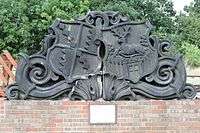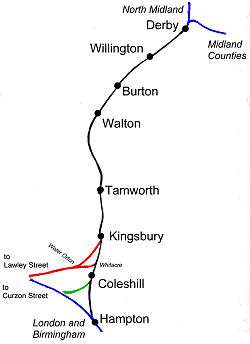Birmingham and Derby Junction Railway
The Birmingham and Derby Junction Railway was a British railway company. From Birmingham it connected at Derby with the North Midland Railway and the Midland Counties Railway at what became known as the Tri Junct Station. It now forms part of the main route between the West Country and the North East.
 | |
 Map of the route of the Birmingham and Derby Junction Railway | |
| Overview | |
|---|---|
| Headquarters | Derby |
| Reporting mark | BDJR |
| Dates of operation | 1839–1844 |
| Successor | Midland Railway |
| Technical | |
| Track gauge | 4 ft 8 1⁄2 in (1,435 mm) standard gauge |
| Length | 42 miles (68 km) |
| Stations and landmarks |
|---|
|
Original stations shown in bold type |
| Birmingham and Derby Junction Railway | ||||||||||||||||||||||||||||||||||||||||||||||||||||||||||||||||||||||||||||||||||||||||||||||||||||||||||||||||||||||||||||||||||||||||||||||||||||||||||||||||||||||||||||||||||||||||||||||||||||||||||||||||||||||||||||||||||||||||||||||||||||||||||||||||||||||||||||
|---|---|---|---|---|---|---|---|---|---|---|---|---|---|---|---|---|---|---|---|---|---|---|---|---|---|---|---|---|---|---|---|---|---|---|---|---|---|---|---|---|---|---|---|---|---|---|---|---|---|---|---|---|---|---|---|---|---|---|---|---|---|---|---|---|---|---|---|---|---|---|---|---|---|---|---|---|---|---|---|---|---|---|---|---|---|---|---|---|---|---|---|---|---|---|---|---|---|---|---|---|---|---|---|---|---|---|---|---|---|---|---|---|---|---|---|---|---|---|---|---|---|---|---|---|---|---|---|---|---|---|---|---|---|---|---|---|---|---|---|---|---|---|---|---|---|---|---|---|---|---|---|---|---|---|---|---|---|---|---|---|---|---|---|---|---|---|---|---|---|---|---|---|---|---|---|---|---|---|---|---|---|---|---|---|---|---|---|---|---|---|---|---|---|---|---|---|---|---|---|---|---|---|---|---|---|---|---|---|---|---|---|---|---|---|---|---|---|---|---|---|---|---|---|---|---|---|---|---|---|---|---|---|---|---|---|---|---|---|---|---|---|---|---|---|---|---|---|---|---|---|---|---|---|---|---|---|---|---|---|---|---|---|---|---|---|---|---|---|
| ||||||||||||||||||||||||||||||||||||||||||||||||||||||||||||||||||||||||||||||||||||||||||||||||||||||||||||||||||||||||||||||||||||||||||||||||||||||||||||||||||||||||||||||||||||||||||||||||||||||||||||||||||||||||||||||||||||||||||||||||||||||||||||||||||||||||||||
Origins
Although Birmingham was served by an extensive canal network, indeed, it is suggested they were a factor in its growth as an engineering centre, there were technical problems since Birmingham was on rising ground.
As early as 1824, Birmingham businessmen had been looking at the possibilities of the railway. The London and Birmingham Railway and the Grand Junction Railway had obtained their necessary Acts of Parliament in 1833 and a scheme for a line to Gloucester and Bristol was in the air. The North Midland had been floated in 1833 and a proposal was made to connect to its terminus at Derby
George Stephenson surveyed the route in 1835. The bill envisaged the line as running through Whitacre to meet the London and Birmingham Railway with a junction at Stechford to travel into the latter's terminus at Curzon Street. It would also run from Whitacre to Hampton-in-Arden, where it would join the L&B for connections to London.
The promoters came into conflict with those of the Midland Counties Railway even before the bills were presented to Parliament since the lines would compete with each other. In the end, the Birmingham and Derby line agreed to withdraw its branch to Hampton if it the Midland Counties withdrew its line along the Erewash valley.
The Hampton branch was removed, but when the Midland Counties presented its bill, it still contained the Erewash line (although it was later dropped on the insistence of the North Midland Railway). Samuel Carter, the Birmingham and Derby solicitor, immediately issued the statutory notices for its branch and was able to incorporate it in the act.[1][2] Royal assent for the Birmingham and Derby Junction Railway Bill was given on 19 May 1836 with the active support of the Prime Minister Robert Peel, the member for Tamworth.[3] The branch later became known as the Stonebridge Railway.
Construction
George's son Robert Stephenson took on the post of engineer, with an assistant, John Birkinshaw. Some 42 miles (68 km) long, there was no gradient steeper than 1 in 339. The design included two viaducts (the Anker Viaduct, now known as the Bolehall Viaduct[4]) and the Wichnor Viaduct (also known as the Croxall Viaduct), seventy eight bridges and a cutting at the approach to Derby, consideration being given to the danger of flooding by the River Trent.
The Anker Viaduct is 807 feet (246 m) long, and the Croxall Viaduct is 1,310 feet (400 m) long.[5]
The rails were single parallel form, 56 pounds per yard (28 kg/m), set in chairs upon cross sleepers. Although the standard gauge was used to match the other railways it was associated with, the rails were actually set at 4 ft 9 in (1,450 mm) apart to allow extra play.
History
Competition
The B&DJR opened on 12 August 1839[6] with the line into Hampton, where the trains would reverse for Birmingham. There were six stations in addition to Hampton and Derby. These were Coleshill (later renamed Maxstoke), Kingsbury, Tamworth, Walton, Burton and Willington.
From the start the joint use of Curzon Street terminus, with the London and Birmingham, gave problems. On 10 February 1842[7] a new line was opened with a new terminus at Lawley Street. This proceeded to Whitacre via Castle Bromwich, Water Orton and Forge Mills (later renamed Coleshill). The line from Whitacre to Stechford which had not been built, was abandoned, and that to Hampton was reduced to single track.
Strong competition between the line and the Midland Counties Railway for transport, particularly of coal, to London, almost drove both of them out of business.
The B&DJR offered a time from Derby to London of around seven hours, but when the MCR began operating it was able to make the journey in an hour less. The B&DJR lowered its fares but this simply resulted in a price war. In a war of "dirty tricks", the MCR made an agreement with the North Midland for exclusive access to its passengers. In retaliation the Birmingham board opposed a bill that the MCR had submitted to Parliament. Both lines were in dire straits and paying minuscule dividends.
The North Midland was also suffering severe financial problems arising from the original cost of the line and its buildings. At length George Hudson took control of the NMR and adopted Robert Stephenson's suggestion that the best outcome would be for the three lines to merge.
Hudson foresaw that the directors of the MCR world resist the idea and made a secret agreement with the B&DJR for the NMR to take it over. This would of course take away the MCR's customers from Derby and the North and, when news leaked out, shares in the B&DJR rose dramatically.
Hudson was able to give the MCR directors an ultimatum, and persuaded the line's shareholders to override their board and the stage was set for amalgamation.

Midland Railway
In 1844, the Birmingham and Derby Junction Railway, the Midland Counties and the North Midland Railway merged to form the new Midland Railway.[8]
The route to Hampton-in-Arden immediately lost all importance when the companies merged, since London traffic was redirected through the shorter Midland Counties route via Rugby. Known as the Stonebridge Railway, it became a minor branch line, and struggled on as such with only one daily passenger train until 1917, when this train was withdrawn as a wartime economy measure. The line remained open until 1935 for freight-only closing when one of the original timber bridges failed. The old Birmingham and Derby Junction station building at Hampton can still be seen.
The line into Lawley Street remained important, however, for passengers to the South West, who would join the Birmingham and Gloucester Railway at Camp Hill station or, from 1841, Curzon Street.
Present day
It is now part of the main line from the North East and Newcastle, via Derby and Birmingham New Street, to the south West at Bristol Temple Meads. CrossCountry is now the principal operator on the line.
References
- Williams, F.S. (1888). The Midland Railway (5th ed.).
- Ronalds, BF (Spring 2018). "Samuel Carter (1805-78): Early Railway Solicitor". Midland Railway Society Journal. 67: 11–13.
- "Imperial Parliament. Thursday". Birmingham Journal. England. 21 May 1836. Retrieved 25 October 2017 – via British Newspaper Archive.
- Historic England, "Bolehall Viaduct (1293304)", National Heritage List for England, retrieved 30 October 2017
- Mogg, Edward (1840). Mogg’s Handbook for Railway Travellers. Edward Mogg. p. 229-230.
- "The Birmingham and Derby junction railway". Worcester Journal. England. 15 August 1839. Retrieved 25 October 2017 – via British Newspaper Archive.
- "On Wednesday Last...". Aris’s Birmingham Gazette. England. 14 February 1842. Retrieved 25 October 2017 – via British Newspaper Archive.
- Barnes, E.G. (1969). The Rise of the Midland Railway 1844–1874. Augustus M. Kelley, New York. p. 308.
- Clinker. C.R., (1982) The Birmingham and Derby Junction Railway, Avon-AngliA Publications and Services.
- Williams, R., (1988) The Midland Railway: A New History, Newton Abbot: David and Charles
- Whishaw, F., (1842) The Railways of Great Britain and Ireland London: John Weale repub Clinker, C.R. ed (1969) Whishaw's Railways of Great Britain and Ireland Newton Abbot: David and Charles
- Pixton, B., (2005) Birmingham-Derby: Portrait of a Famous Route, Runpast Publishing
Further reading
- Whishaw, Francis (1842). The Railways of Great Britain and Ireland Practically Described and Illustrated (2nd ed.). London: John Weale. pp. 15–18. OCLC 833076248.CS1 maint: ref=harv (link)